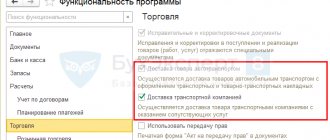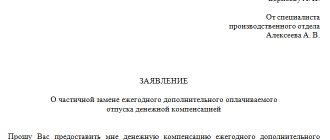Formula for calculating TRP for the remaining goods
Most companies use the methodology prescribed in Article 320 of the Tax Code of the Russian Federation. This formula for calculating TZR should apply exclusively to transportation costs. The remaining costs associated with the sale are written off in full. In this way, the company will be able to bring accounting and tax accounting at the enterprise as close as possible.
For the distribution of TZR, it would be fair to use the following calculation option:
K = (TP0 + TR1) / (T1 + T2) * 100%, where:
- K is the average percentage of transportation costs for the remaining goods at the end of the month;
- TP0 are those transportation costs that fall on the balance of unsold products at the beginning of the period;
- TP1 – transport costs incurred in the month under review;
- Т1 – purchase price of products sold in this period;
- T2 – the cost of purchasing products that remained unsold.
After which, transportation costs for the remaining goods are calculated by multiplying the indicators T2 and K.
Example . calculates transportation costs for the remaining goods. In April 2021, products were sold with a total cost of 800,000 rubles. Goods worth 200,000 rubles remained unsold. The balance of TRP at the beginning of the month was 25,000 rubles, and the total amount of TRP for April was 45,000 rubles. How to calculate the TRP for the balance in this case?
Let's use the previously given formula:
P = (25,000 + 45,000) / (800,000 + 200,000) * 100% = 7%. Therefore, transportation costs for the remainder will be: 200,000 * 0.07 = 1,400 rubles.
Moreover, the remaining expenses from last month and the expenses incurred, minus those that fall on the balance, can be written off as cost. That is, you first need to calculate the TZR for write-off: 25,000 + 45,000 – 1,400 = 68,600 rubles.
What do shipping costs include?
The essence of TR depends on the activities of the organization. For example, a company produces equipment, machinery, raw materials, and various goods. All product units are intended for sale to customers. When concluding a contract with a buyer, it is necessary to transport products from point A to point B. This is usually the responsibility of the seller. The company can also purchase raw materials for the production of its products. Its delivery will also require funds. So, transportation costs include:
- Expenses for the delivery of purchased items (products, raw materials, fixed assets).
- Costs for delivering products to customers.
- Costs for maintaining your own vehicle fleet (this includes costs for car rental, gasoline, repairs and diagnostics of cars).
Question: Can the buyer demand that the supplier compensate for losses in the form of payment for transportation costs for the return of low-quality goods and payment for its storage at a price higher than the market price? View answer
Transport costs can be very high. In this case, they immediately attract the attention of the company’s management and tax authorities. Therefore, an accountant needs to devote time specifically to accounting for expenses related to transportation.
IMPORTANT! Typically, transportation costs are included in the cost of the final product. If the management team decides to reduce the cost of goods, then it makes sense to optimize transportation costs. This process is carried out based on information about expenses that can be obtained from accounting. All data is carefully analyzed, after which a decision is made to exclude certain sources of spending.
For example, an enterprise maintains its own fleet of vehicles, but the cars are used relatively rarely. However, their rare use does not exclude associated expenses. Therefore, the manager decides to disband the fleet. Delivery of products will be carried out under an agreement with a third-party company.
Question: Is a transport invoice required to confirm transport expenses in tax accounting if the buyer has entered into an agreement with a freight forwarder to deliver the goods? View answer
How to calculate TZR based on materials?
Transport costs of an enterprise may be associated with the purchase of not only finished goods, but also materials that are subsequently used in production. In this case, it is necessary to correctly distribute the incurred TRP. This can be done in several ways in accordance with PBU 5/01:
- using account 15 (TZR is written off against the procurement and purchase of materials);
- using a separate sub-account for goods and materials on account 10 “Materials”;
- by directly including the incurred TRP in the cost of materials.
The last option allows you to minimize calculations. And in the first two cases, how to calculate the TZR? The formula for write-off is specified in the Methodological Instructions for Deviations or TZR (clause 87). The calculation must be made as follows:
K = (Off0 + Off1) / (M0 + M1) * 100%, where:
- K – percentage of write-off of equipment;
- Off0 – the amount of remaining TZR at the beginning of the period;
- Off1 – the amount of TZR incurred in the month under review;
- M0 – remaining materials at the beginning of the month;
- M1 – the amount of materials purchased per month.
Moreover, the cost of materials is taken as indicated in the accounting documents. After that, the TRP for materials is calculated by multiplying the resulting percentage by the accounting cost of the materials written off as production costs.
What types of transportation and procurement costs are subject to distribution?
According to Art. 320 of the Tax Code of the Russian Federation, the procedure for writing off expenses for the sale of goods can be presented in the form of a diagram:
Expenses marked with green circles are fully written off in the month they are incurred. But expenses that are marked with red circles can be written off only in the part related to goods sold. In other words, the cost of purchasing goods and transportation costs for delivering them to the place of storage (resale) at the end of the month should be distributed between sold and unsold goods.
The purchase price of goods (their actual cost) may include (clauses 11, 12 FSBU 5/2019):
- amounts paid to the seller taking into account all discounts and markups (excluding VAT);
- costs of procurement and delivery of inventories to the place of their consumption (sale, use);
- costs of bringing inventories to a state in which they are suitable for use for the intended purposes (refinement, sorting, packaging, improving technical characteristics);
- other charges.
Since 2021, inventory accounting is regulated by the new FSBU 5/2019 “Inventories”, PBU 5/01 has become invalid. ConsultantPlus experts explained what changes the new standard brought. Get free demo access to K+ and go to the Ready Solution to find out all the details.
The purchase price of goods sold is written off in one of the ways that must be recorded in the accounting policy:
- at the purchase price of those goods that were purchased earlier in relation to other goods (FIFO);
- at the purchase price of a unit of goods;
- based on the average cost of goods purchased.
You can find detailed explanations on writing off the cost of goods using the average cost method in our article “Procedure for writing off materials using the average cost method.”
Transportation costs for delivering goods to the place of storage (resale) may include:
- transport services of third parties;
- services for loading and unloading goods, their support;
- material costs for retrofitting vehicles (insulation, fixing racks, protective materials, etc.);
- services for short-term storage of goods at railway stations, river (sea) ports, airports. The terms of such storage must be specified in the contract for the transportation of goods.
We will take a closer look at the procedure for determining the amount of transportation expenses to be written off at the end of the month in the next section of the article.
How to calculate TZR for cargo delivery?
Often, enterprises are forced to deliver cargo themselves or pay for this service to the supplier. As a result, their final cost increases. In this regard, there is a need to calculate transport costs for cargo delivery.
Not all enterprises are ready to calculate and take into account the technical requirements for each batch - this requires a lot of time, and in such calculations one can easily make a mistake. In this regard, some organizations determine transport tariffs depending on the distance of transportation. This allows you to quickly make calculations. Some even use the state tariff system.
In this case, it is possible to calculate transportation and procurement costs more accurately by determining the cost of delivering 1 ton of cargo per 1 km of route.
Similar articles
- Nuances of postings debit 10 credit 10
- Transportation and procurement costs
- Accounting for transport costs
- Accounting for transport costs in the estimate
- General production costs: calculation formula
Composition of transport costs
According to paragraph 2.2 of the Methodological Recommendations of Roskomtorg in
accounting
Transportation costs include the following types of costs:
— payment for transport services of third-party organizations for the transportation of goods and products (payment for transportation, for supplying wagons, weighing goods, etc.);
— payment for the services of organizations for loading goods and products into and unloading vehicles, fees for forwarding operations and other similar services;
— the cost of materials spent on equipment of vehicles (boards, hatches, racks, racks, etc.) and their insulation (straw, sawdust, burlap, etc.);
- payment for temporary storage of goods at stations, piers, ports, airports within the regulatory time limits established for the export of goods in accordance with concluded agreements;
- fees for servicing access roads and non-public warehouses, including fees to railroads in accordance with agreements concluded with them.
profit tax purposes
, is not established by tax legislation. Let's try to determine the list of these expenses based on other regulations. This right is provided by paragraph 1 of Article 11 of the Tax Code of the Russian Federation. It says that the institutions, concepts and terms of civil, family and other branches of Russian legislation used in the Tax Code are used in the meaning in which they are used in these branches of legislation. Of course, unless otherwise provided by the Code.
When determining the composition of transport expenses in tax accounting, organizations can use the All-Russian Classifier of Types of Economic Activities (OKVED). Thus, according to OKVED class 63 “Auxiliary and additional transport activities” includes loading and unloading of cargo and luggage (group 63.11 “Transport processing of goods”), as well as storage and warehousing of all types of cargo (group 63.12 “Storage and warehousing”) and other types activities related to the transportation of goods. It turns out that transportation costs also include related services.
Thus, for tax accounting purposes, it is possible to accept the same composition of transport costs as in accounting. However, the list of these expenses must be approved in the tax accounting policy.
If part of the goods is lost in transit
Natalya Gasheeva, head of the methodology and quality control department of the outsourcing division of BDO Russia, gave a comment for the magazine “Accounting: simple, clear, practical.” If the carrier has paid compensation for goods lost in excess of the norm, no tax base arises. There is no need to reflect the amount of compensation in tax accounting as income, since in this case the owner of the goods does not receive any economic benefit. Accordingly, the cost of the lost goods does not form an expense in tax accounting. UNDER THE TERMS OF THE DELIVERY AGREEMENT, OWNERSHIP OF THE GOODS WAS TRANSFERRED TO THE BUYER AT THE MOMENT OF TRANSFER TO THE CARRIER. THE PRODUCT ARRIVED WITH A SHORTAGE TO THE BUYER. IN SUCH A SITUATION, THE SUPPLIER HAS NO LIABILITY. THEREFORE, THE BUYER MUST PAY THE FULL AGREEMENT PRICE OF THE GOODS. IN THIS WAY, ONLY THE GOODS ACTUALLY ARRIVED, WHICH IN RANGE AND QUALITY COMPLY WITH THE CONDITIONS OF THE DELIVERY AGREEMENT, WILL BE RECEIVED IN THE WAREHOUSE. LET'S FIND OUT HOW TO REFLECT THE SHORTAGE IN ACCOUNTING AND TAX ACCOUNTING. IF PART OF THE GOODS IS LOST IN TRANSIT. Accounting When reflecting shortages of goods, you must be guided by the Methodological Instructions for Accounting of Inventories (approved by Order of the Ministry of Finance of Russia dated December 28, 2001 No. 119n). First, it is necessary to determine what part of the loss is due to natural decline, and what part is in excess of it. Each of them has its own accounting procedure. Natural loss To determine the amount of shortages within the limits of natural loss norms, you must first calculate the quantity (volume) that was lost “naturally.” The rates of natural loss are different for different inventories and different types of transport. They are developed and approved by ministries and departments (Resolution of the Government of the Russian Federation of November 12, 2002 No. 814). For example, the rate of natural loss of crushed stone when transported in bulk by road is 1.3 percent of the mass of the transported cargo (Resolution of the USSR State Supply Committee dated 06/08/1987 No. 78 “On approval of the rate of natural loss of building materials during transportation by road”). If, for example, 100,000 kg are transported, then the natural loss will be 1,300 kg (100,000 kg × 1.3%). Then we calculate the amount of the shortfall. To do this, the number of missing goods (within the standard) must be multiplied by the supplier’s contractual (sales) price. Other expenses, including transportation costs and VAT related to them, are not taken into account. The shortage within the limits of natural loss norms is not included in the amount of the claim submitted to the carrier. It is written off from the credit of the settlement account in correspondence with the debit of account 94 “Shortages and losses from damage to valuables.” At the same time, the missing goods are written off from account 94 and charged to the transportation and procurement costs of the trading company. In excess of the norms of natural loss Shortages of goods in excess of the norms of natural loss are accounted for at actual cost. The actual cost includes (clause 58 of the Guidelines for accounting for inventories):
- Cost of missing goods. To determine it, you need to multiply the number of missing goods in excess of the norms of natural loss by the contractual (sales) price of the supplier (excluding VAT). For excisable goods, excise taxes are included in the contract price.
- The amount of transportation and procurement costs that the buyer must pay - in the share related to the missing goods. To determine this share, you need to divide the amount of transportation costs (excluding VAT) for this delivery by the total cost of goods (at the supplier’s sales prices) excluding VAT. The result is then multiplied by the cost of the missing goods.
- The amount of VAT relating to the basic cost of missing goods and to the transport costs associated with their acquisition.
The actual cost of shortages and damage in excess of the norms of natural loss is taken into account as a debit to the claims settlement account and written off from the credit of the settlement account (clause 59 of the Methodological Instructions for Accounting for Inventory).
If by the time the shortage is discovered the company has not yet paid for the carrier’s services, then the portion attributable to the missing goods in excess of the norms of natural loss is deducted from the agreed payment amount. In this case, unpaid amounts are not reflected in the claims settlement account. Income tax Losses from shortages of goods during transportation within the limits of natural loss norms are taken into account as part of material expenses (subclause 2, clause 7, article 254 of the Tax Code of the Russian Federation). “Excessive” losses, according to the Ministry of Finance, can only be taken into account in cases where the culprits have not been identified, and the company has an official document confirming this fact (subclause 5, paragraph 2, Article 265 of the Tax Code of the Russian Federation, letter from the Ministry of Finance of Russia dated April 28, 2010 No. 03-03-06/1/300).
If the company filed a claim with the carrier, he acknowledged it and paid compensation, then, as a general rule, the latter must be recognized as non-operating income and taken into account on the date of recognition of the debt (clause 3 of Article 250, subclause 4 of clause 4 of Article 271 of the Tax Code of the Russian Federation) . Moreover, if the contract does not establish the amount of compensation, and the company did not go to court with a claim for compensation for losses, then there is no need to take into account compensation in income (Article 317 of the Tax Code of the Russian Federation).
VAT The company accepts the amount of VAT on the registered goods for deduction after registration of the goods in the presence of a supplier invoice (subclause 2, clause 2, article 171, clause 1, article 172 of the Tax Code of the Russian Federation). She also has the right to deduct VAT related to commodity losses within the limits of natural loss (paragraph 2, paragraph 7, article 171 of the Tax Code of the Russian Federation, letter of the Ministry of Finance of Russia dated August 15, 2006 No. 03-03-04/1/628). VAT attributable to losses in excess of the norms of natural loss cannot be deducted (clause 7 of Article 171 of the Tax Code of the Russian Federation). Example from practice Let's say the purchasing company purchased 100 tons of crushed stone at a price of 1,770 rubles/t for a total amount of 177,000 rubles. (including VAT - 27,000 rubles). Under a supply agreement, ownership passes to the buyer at the time the goods are transferred from the seller's warehouse to the carrier. Delivery is carried out by a third party, delivery cost is 10,620 rubles. (including VAT - 1620 rubles). Payment for delivery is made after acceptance of the goods by the buyer. At the time of acceptance, a shortage of 8 tons was detected. The carrier acknowledged the claim and returned the funds in the amount of the identified shortage. The rate of natural loss of crushed stone when transporting in bulk by road is 1.3 percent of the mass of the transported cargo (Resolution of the USSR State Supply Committee dated 06/08/1987 No. 78). This norm does not depend on the distance of transportation and is applied only in the event of an actual shortage of cargo. Before making entries, the accountant will have to make some calculations:
- The rate of natural loss will be 1300 kg (100,000 kg × 1.3%). This means that losses in excess of the standard are equal to 6700 kg (8000 kg - 1300 kg.)
- The amount of crushed stone shortage is within the limits of natural loss.
EXPERT OPINION Compensation is not included in income Natalya Gasheeva, head of the methodology and quality control department of the outsourcing division of BDO Russia: In the case when a company received compensation from a carrier for goods lost in excess of the norm, then it does not have a tax base for income tax. There is no need to reflect the amount of compensation in tax accounting as income, since in this case the owner of the goods does not receive any economic benefit. Accordingly, the cost of the lost goods does not form expenses in tax accounting. You can read the full version of the article in the magazine “Accounting: simple, clear, practical”, No. 18, September 2012








